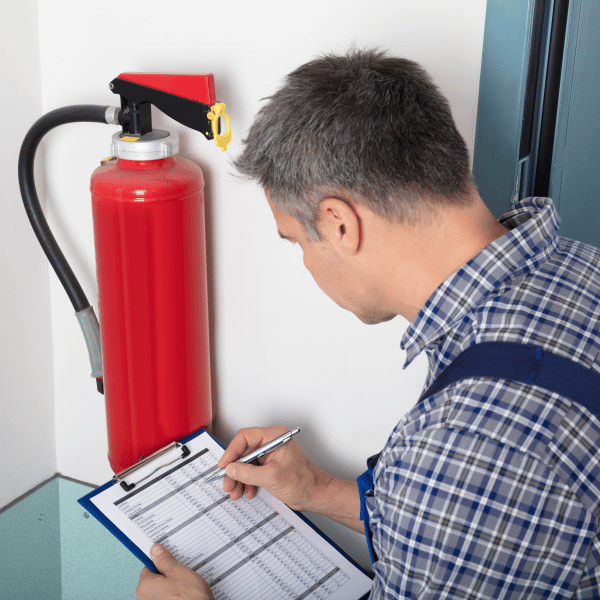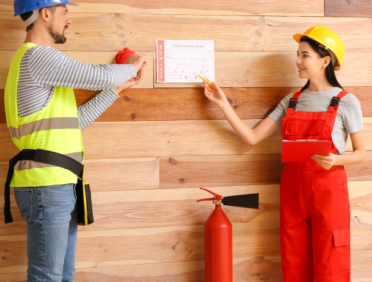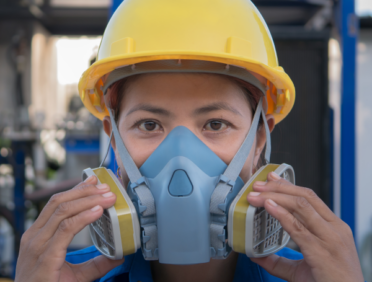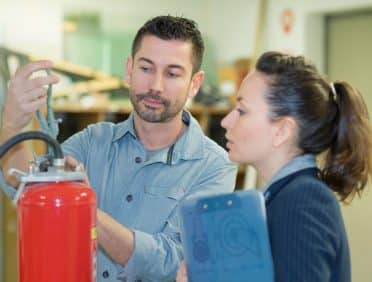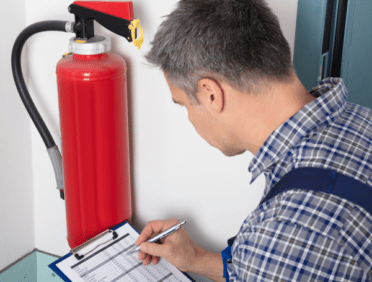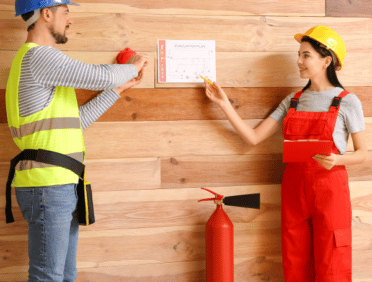When it comes to dealing with small fires in the workplace, one thing is for sure; you always need to ensure that everyone gets out safely, and this is your main concern.
That said, fire extinguishers can definitely help those in your workplace who know how to use them to put out the fire before it starts to spread in a way that is safe.
As a part of fire safety training, let us take a look at some of the main aspects of fire safety and also how fire extinguishers can be used and which ones are most relevant at certain times.
The best place to start when it comes to fire extinguishers is actually to look at a more general overview of fire safety.
A warning and detection system
The first general fire precaution that you should take is to ensure that you have both fire detection and fire warning system in place in your premises. For some, this could be as simple as a process in place to shout a warning. However, this route is not suitable for bigger premises with more staff. In this case, an actual fire alarm system is going to be a much better idea.
Safe exit routes
The main aim of fire safety is to make sure that everyone on the premises can get out safely. This means that you should never overlook having safe routes for escape. It is advised that you have more than one exit route from your premises; however, should you find that this is not possible, then you are going to want to make sure that any exits that you may use are fire resisted.
All exits should also be signposted to ensure that they can easily be found, even if there is no normal lighting in the building.
Not only this, but the exits that you do have should lead as directly as possible to a safe meeting place that can be used to ascertain whether or not anyone is left in the building.
Ways to fight smaller fires
Next, you should have a way of fighting smaller fires. A multi-purpose fire extinguishers may be the most recommended approach to take (although we will look at more specialist fire extinguishers later on, should you feel that these are necessary). It is said that you should always aim to have a fire extinguisher every 200m of floor space, with one on every single floor of your building.
Fire exit doors that are suitable
Doors that are used as a part of a fire escape route should be easy to open. They should not be locked or fastened, and they should not be complicated to open. They should also be standard opening doors, as sliding doors and revolving doors are not to be used as a part of a fire escape plan.
The Regulatory Reform (Fire Safety) Order 2005
The Regulatory Reform (Fire Safety) Order of 2005 is a long document that applies to businesses throughout England and Wales. Of course, you can choose to read the entire order yourself and find out more about what it contains, but if you want to have an overview that breaks it down and ensure that you are aware of the key points, then we have put together all the information that you are going to need.
Who is it aimed at?
As we have already covered, the Oder applies to businesses; however, what you may not realise is that it also applies to structures and buildings that can be identified as more than a private homes. This could apply to a block of flats.
Another type of building that can be covered by this Order is HMOs, as they are a property that is lived in by several people.
What are the responsibilities of the business or property owner?
There are two main responsibilities that fall to the business owner or the owner of the property. These are:
- That the premises reach the required standards
- That employees are provided with adequate fire safety training
Adequate fire safety training will vary depending on the business. However, it will usually cover- induction training that will cover general fire safety awareness, refresher training at regular intervals, or organised when the level of fire risk changes in your business.
It also includes training to support those people who are appointed to a specific fire safety role within your business.
Carrying out fire risk assessments
Another key part of the order is the requirement to carry out a detailed assessment within any commercial premises; this should cover the risk and hazards that are within the premises that relate to fire.
This fire risk assessment should be completed by someone who is competent and should be recorded (if you have more than five team members within your business).
Some of the key aspects of a fire risk assessment that should be kept in mind include the following:
- Considering who is most at risk
- Reducing or eliminating risk as much as possible
- Providing general fire precautions
- Taking any additional measures should there be flammable or explosive materials
- Create a plan to deal with a fire emergency
- Maintain any general fire precautions
- Keep the assessment and review it when necessary
Training in the use of fire extinguishers
Whilst it is necessary to have fire extinguishers within the premises in order to keep everyone safe, there isn’t really a point in doing this unless you provide training on how to use them. This means that an effective fire extinguisher training programme should be a part of your fire safety plans.
It is good to cover the basics of the use of fire extinguishers; however, to really ensure that your team members feel that they are empowered in using these pieces of equipment, a more comprehensive approach should be taken to training.
Not only will fire extinguisher training cover how to use them, but it will also help with other aspects of fire safety, such as the classifications of fire and which colour of extinguisher should be used in different fire circumstances. That way, they can have everything that they are going to need in order to be properly aware of fire safety and their place within it.
Fire Classifications (different types of fire)
There are five classifications of fire that you should be aware of. These are:
- Class A fires- solid materials
- Class B fires- liquids and gases
- Class C fires- electrical
- Class D fires- metallic
- Class K fires- grease or oil, specifically cooking
Class A fires are usually referred to as ordinary fires, and they are the most common of them all. They occur when common materials that are combustible (such as paper, wood, fabric and rubbish) catch fire. These fires can happen in a variety of business types (as well as other premises and even homes) which means that having a level of protection against them is going to help you to feel safer.
Class B fires will involve flammable liquids and gases; these will usually be a thing such as gasoline and kerosene. Other gases that you may find that are Class B are propane and butane; these are highly flammable.
Class C fires are electrical fires and are usually seen on premises that have heavy use of electrical equipment. This includes office spaces as well as construction sites. Electrical power tools and cooking appliances are often the cause of electrical fires, as is bad wiring.
Class D fires are metallic fires, and they are not as common as other forms. They can be quite hard to extinguish due to the fact that they cannot be put out with water and involve materials that are incredibly flammable and can often be volatile when mixed with heat sources.
Class K fires are grease and cooking fires. You may think that they should fit into Class B, but they actually have their own classification. They are most often found in the restaurant and food industry, and they occur because the materials that are used in cooking can easily combust. They are recognised as being one of the most dangerous types of fire, and they can spread quickly and easily.
Which fire extinguisher should I use?
In order to properly fight and extinguish any fire that you come across, you are going to need to use the right type of fire extinguisher. If you do not use the right type of fire extinguisher, then you run the risk of not only not being able to extinguish the fire effectively but also making the entire situation worse (and not to mention more dangerous).
This is why it is important to be able to ascertain which fire extinguisher should be used in which circumstance.
Water mist extinguishers (red label)
The most common form of fire extinguisher is a water fire extinguisher. These can either be water mist extinguishers, which produce microscopic particles of water from the nozzle, or water spray.
Water mist fire extinguishers will suffocate the fire and will also create a mist wall between the fire and the person who is using the extinguisher, which means that they are protected from some of the feelings of heat.
Water mist extinguishers have a red label and can be used on fires that are caused by organic materials. This includes paper, cardboard, fabrics and wood.
Water spray fire extinguishers (red label)
Another fire extinguisher that has a red label is a water spray fire extinguisher. They can be used in just the same way, on the same types of fires. However, the difference in these is that they have a spray nozzle. This means that the water that is released can cover a much wider surface area.
Spray fire extinguishers are able to put out a fire quicker than mist. However, they do not offer the protective wall that a mist fire extinguisher is able to offer.
Foam extinguishers (cream label)
Fire extinguishers that have a cream label are foam extinguishers. They are used primarily for Class B fires. However, they can also be used in Class A fires too.
As well as being suitable for organic materials (the same as a red-label fire extinguisher) they can also be used on flammable liquids such as paint and petrol.
They work by cooling down the liquids that are on fire. They also create a barrier between the flame and the fuel that is making it burn, which will extinguish the fire.
Dry powder extinguishers (blue label)
A dry powder extinguisher will have a blue label. They are often referred to as ABC extinguishers because they are known to be able to treat both A, B and C fire classifications.
The issue with this type of extinguisher (and why it is often not used) is that they spray out a dry powder, which is not suitable for enclosed spaces. It can easily be inhaled during use. It also is much harder to clean up the residue after they have been used compared to other fire extinguisher types.
Some electrical fires can be put out using dry powder extinguishers. However, you will need to research this. You may also find that you can buy a specialist dry powder type that is suitable for flammable metals.
CO2 extinguishers (black label)
If a fire extinguisher has a black label, then it is a CO2 extinguisher. These are usually used for electrical fires, and therefore they are seen in computer server rooms more often than not. Whilst this is their most common use, these fire extinguishers can also be used to put out Class B fires.
They work by displacing the oxygen that is in the air and is needed for the fire to burn; this suffocates the fire and stops it in its tracks.
Wet chemical extinguishers (yellow label)
Fires that are found to be Class F (which means that they involve cooking oils and fats) can be put out by wet chemical fire extinguishers. These have a yellow label. In an emergency, these can also be used to put out Class A fires. However, you usually see other fire extinguishers used.
They work by creating a layer of foam on the burning oil or the burning fat. This will stop any further oxygen from fueling the fire. It also cools things down.
In the case of an electrical fire, it is important that a CO2 fire extinguisher is used. This will not only stop the fire by removing the oxygen and, therefore, the fuel from the air. But, because they do not spray out any residue, powder, water or foam, then they are also not going to harm any surrounding pieces of electrical equipment.
Colour Codes
It is important to have the colour codes on fire extinguishers because this helps you to be able to identify them in a hurry. It also helps those who may have issues with the accessibility of the names on them to still be able to use a fire extinguisher in an emergency situation.
How to use a Fire Extinguisher
Once you have ascertained whether or not a fire extinguisher is going to be the right one for you to use, then you need to get to grip on how to actually use them.
Before you even begin to use a fire extinguisher, you need to make sure that you know your exit route. This is because the most important thing in a fire is to ensure that you are safe and that you are going to be able to escape should the fire extinguisher not work.
You then need to stand back, keeping your back to the exit route and your face to the fire. You should always be around 6 to 8 feet away from the flames, as this is the safest distance.
To discharge the fire extinguisher, you should start by pulling the pin. Then you aim the nozzle on the hose; this should be low and towards the base of the fire.
Once you have aimed the spray, you need to squeeze the handle (or the lever depending on the design of the extinguisher) and discharge it.
In order to put the fire out, you should always aim at the base of the fire and move from side to side, carrying on doing so until the fire is completely extinguished.
The fire may start up again, so you should keep an eye on it; the fire department should also be called, if not before this point, then at this point so that they can come and help with the situation.
Once the fire is out, or if you have not been able to put the fire out, then you need to leave the scene and get yourself to safety.
Other Fire Safety Equipment
As well as having fire extinguishers to help to put out the fire, there are other fire safety equipment items that you can buy and have on your premises.
Fire blankets
A fire blanket is a safety device which is made from specially woven fabric. It is fire retardant and is able to extinguish small fires that are only just starting. They will not only smother the flames, but they will also starve them of oxygen too. They are usually used before the fire can get out of control.
Hoses
These hoses are high-pressure hoses that will carry water or any other fire-retardant materials to extinguish the fire. There are three types of fire hoses. They are named by their output, and the higher the number, the larger the fire that they can put out.
Buckets
A fire bucket is a metal bucket that is filled with either sand or water. This is used to extinguish fires. The sand is most often used when the fire is a spilt flammable liquid which may ignite and then spread across the ground.
Automatic fire extinguishers
An automatic fire extinguisher is most often used in computer cabinets. They contain an inert gas, which will be released when the temperature reaches a certain point. This gas will then suffocate a fire.
Vehicle fire extinguishers
As the name suggests, a vehicle fire extinguisher is a fire extinguisher that is used within a vehicle. They are usually much smaller, which means that they are portable. They can also be stored easier in a car too. Other than that, they look just like your standard fire extinguishers and are labelled and colour coded the same.
Positioning of extinguishers
Extinguishers should be placed in a way that it should not be necessary to travel too far in order to put out a fire. This is usually in main exits or entrances, which will be easy to find. You should not hide them behind a screen, or a door as this will make them harder to find or harder to access, which means that having them is pointless.
It is also a good idea to have a fire extinguisher at the top and the bottom of the stair; this means that they are on the fire exit route, and therefore you can use them as you exit.
You should never have to go through more than two doors to get to an extinguisher that you can then use, nor should you have to go to a different floor to get one.
It is also advisable to have extinguishers in specific areas of risk, such as a kitchen, a server room or where there is a main electrical intake or machine.
Fire Extinguisher Servicing
When it comes to fire extinguishers, they need to be serviced just like many other safety equipment items that you may have on your premises. It is recommended that you organise servicing to be carried out every single year for all kinds of the extinguisher.
Fire extinguishers can last around ten years before they need to be replaced.
Logging Information
Another part of fire safety is to have a fire logbook that is there to record all the events that occur to fire extinguishers. This could be a fire that needed to be extinguished, as well as any maintenance or testing that was carried out on the extinguisher.
To download a .pdf of this blog, please click here
